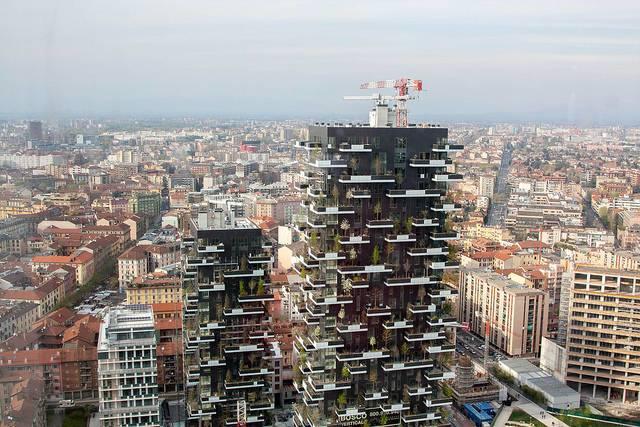
We've heard it time and time again: Trees are the environment's best friend. They help cleanse the atmosphere of excess carbon dioxide and other more harmful gases. In the process, they help restore the oxygen we need to breathe. They provide shade -- a valuable quality in today's warming climate. And they're pretty.
Architects have been struggling for decades to figure out just how to use those qualities best in urban design. Cities like Seattle and Vancouver BC Canada pre-program parks into their city planning. Small towns have grown up with that thinking, too.
But how do you integrate that mindset into densely packed neighborhoods with little room in which to add parks and green spaces?
One architect in Milan, Italy is answering that problem by developing architecture that comes with its own vertical forests.
Some would say architecture is what Milan is all about. Its 15th century Duomo (Cathedral) di Milano and its remarkable 19th century shopping center Galleria Vittorio Emanuele II are just a few of the landmarks that have defined the city most known for its Leonardo da Vinci mural, The Last Supper.
But the centuries of development haven't exactly left a lot of room for climate-friendly green spaces like spacious parks and forests. They do exist, points out blogger Jessica Spiegel, who has counted about a dozen green locations in the city of 1.3 million. But expanding them in a city that was founded some 2,300 years ago is challenging
Unless of course, you're willing to think outside the box (or high rise in this case), like Stefano Boeri, an architect with a specialty in urban redevelopment. His Bosco Verticale (Vertical Forest), which comprises two high-rise apartment buildings in the center of Milan's busy metropolis is designed to increase space not just human habitation, but for forests as well.
Each floor of the 290-360-foot buildings is surrounded by numerous extended planters that can hold dozens of trees, shrubs and other plants that can grow naturally in the Milanese area. With more than 700 trees (some ranging as tall as 29 feet) and 15,000 shrubs and floral plants, the two towers not only provide a lush and scenic view for apartment dwellers, but a home for numerous species of birds and insects that dwell among the "forests."
According to Boeri's firm, laid flat the mini forests would equal almost 5 acres of forest on land. The amount of vegetation that has been allowed to grow over time creates its own microclimate that produces oxygen and removes carbon dioxide from the atmosphere. It also acts as a natural corridor for wildlife, connecting the city's other small parks with the bird and insect population. Arbolists (rather than gardeners) care for the Bosco's natural habitat. Tree specialists are lowered by guy wires to inspect the trees and administer care on a regular basis.
Boeri and his associates, Gianandrea Barreca and Giovanni La Varra completed the "Bosco Verticale" project in 2014. Since that time the team has won numerous awards for its ingenuity and contributions to urban planning.
It's also spawned the imagination of architectural designers around the world, which Boeri, who now heads the Stefano Boeri Architetti firm in Milan and Singapore, makes a point of featuring on his website in an effort to encourage further dialogue about the ways that urban planning can actually integrate elements of nature and conservation.
The firm has also launched a number of other projects in Utrecht (Netherlands), Paris and Liuzhou (China). Liuzhou's "Forest City" is under construction and once completed is expected to be able to absorb as much as 10,000 tons of CO2 per year. Unlike the Vertical Forest of Milan, the office buildings, residences, hotels and public facilities will be "entirely covered by plants and trees."
Stefano Boeri is also renowned for his cultural and artistic contributions. He curates the website TheTomorrow.net, which encourages dialogue among various professions about the future of European culture and its ongoing development.
Flickr images: Alessandro Bovini; Forgemind ArchiMedia; Andrea Passoni
Jan Lee is a former news editor and award-winning editorial writer whose non-fiction and fiction have been published in the U.S., Canada, Mexico, the U.K. and Australia. Her articles and posts can be found on TriplePundit, JustMeans, and her blog, The Multicultural Jew, as well as other publications. She currently splits her residence between the city of Vancouver, British Columbia and the rural farmlands of Idaho.














